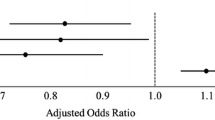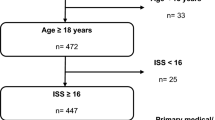Abstract
Purpose
Prehospital estimation of injury severity is essential for prehospital therapy, deciding on the destination hospital and the associated emergency room care. The aim of this study was to compare prehospital estimates of the abbreviated injury scale (AIS) and the Injury Severity Score (ISS) by emergency physicians with the values of AIS and ISS of injury severity determined at the conclusion of diagnostics.
Methods
In this prospective study, the ISS was determined prehospital by emergency physicians. The validated AIS and ISS were analyzed based on final diagnoses. A Bland–Altman plot was used in analyzing the agreement between two different assays as well as sensitivity and specificity were determined. Confidence intervals were calculated for a Wilson score. Significance level was set at p ≤ 0.05.
Results
The prehospital ISS was estimated at 26.0 ± 13.0 and was 34.7 ± 16.3 (p < 0.001) after in-hospital validation. In addition, most of the AIS subgroups were significantly higher in the final calculation than preclinically estimated (p < 0.05). When analyzing subgroups of trauma patients (ISS < 16 vs. ISS ≥ 16), we were able to demonstrate a sensitivity of > 90% to identify a multiple-trauma patient. Diagnosing a higher injury severity group (ISS ≥ 25), sensitivity dropped to 61.1%. The Bland–Altman plot demonstrates that injury severity is underestimated in higher injury levels.
Conclusion
Multiple-trauma patients can be identified using the ISS. Anatomic scores might be used for transport decisions; however, an accurate estimation of the injury severity should also be based on other criteria such as patient status, mechanism of injury, and other triage criteria.


Similar content being viewed by others
References
van Rein EAJ, Houwert RM, Gunning AC, Lichtveld RA, Leenen LPH, van Heijl M. Accuracy of prehospital triage protocols in selecting severely injured patients: a systematic review. J Trauma Acute Care Surg. 2017;83(2):328–39. https://doi.org/10.1097/TA.0000000000001516.
van Laarhoven JJ, Lansink KW, van Heijl M, Lichtveld RA, Leenen LP. Accuracy of the field triage protocol in selecting severely injured patients after high energy trauma. Injury. 2014;45(5):869–73. https://doi.org/10.1016/j.injury.2013.12.010.
Brown J, Sajankila N, Claridge JA. Prehospital Assessment of Trauma. Surg Clin N Am. 2017;97(5):961–83. https://doi.org/10.1016/j.suc.2017.06.007.
Knudson P, Frecceri CA, DeLateur SA. Improving the field triage of major trauma victims. J Trauma. 1988;28(5):602–6.
Carron PN, Taffe P, Ribordy V, Schoettker P, Fishman D, Yersin B. Accuracy of prehospital triage of trauma patients by emergency physicians: a retrospective study in western Switzerland. Eur J Emerg Med. 2011;18(2):86–93. https://doi.org/10.1097/MEJ.0b013e32833e79fe.
Lehmann R, Brounts L, Lesperance K, Eckert M, Casey L, Beekley A, et al. A simplified set of trauma triage criteria to safely reduce overtriage: a prospective study. Arch Surg. 2009;144(9):853–8. https://doi.org/10.1001/archsurg.2009.153.
Baker SP, O’Neill B, Haddon W Jr, Long WB. The injury severity score: a method for describing patients with multiple injuries and evaluating emergency care. J Trauma. 1974;14(3):187–96.
Osler T, Baker SP, Long W. A modification of the injury severity score that both improves accuracy and simplifies scoring. J Trauma. 1997;43(6):922–5 (discussion 5–6)
Balogh Z, Offner PJ, Moore EE, Biffl WL. NISS predicts postinjury multiple organ failure better than the ISS. J Trauma. 2000;48(4):624–7 (discussion 7-8)
Sears JM, Blanar L, Bowman SM. Predicting work-related disability and medical cost outcomes: a comparison of injury severity scoring methods. Injury. 2014;45(1):16–22. https://doi.org/10.1016/j.injury.2012.12.024.
Kim SC, Lee KH, Choi HY, Noble J, Lee K, Jeon HJ. On-scene factors that predict severe injury of patients involved in frontal crashes of passenger cars. Eur J Trauma Emerg Surg. 2016. https://doi.org/10.1007/s00068-016-0714-1.
Bland JM, Altman DG. Statistical methods for assessing agreement between two methods of clinical measurement. Lancet. 1986;1(8476):307–10.
Team RC. A language and environment for statistical computing. R Foundation for Statistical Computing, Vienna, Austria. 2015. http://www.R-project.org/.
Sasser SM, Hunt RC, Faul M, Sugerman D, Pearson WS, Dulski T, et al. Guidelines for field triage of injured patients: recommendations of the National Expert Panel on Field Triage, 2011. MMWR Recomm Rep. 2012;61(RR-1):1–20.
Voskens FJ, van Rein EAJ, van der Sluijs R, Houwert RM, Lichtveld RA, Verleisdonk EJ, et al. Accuracy of prehospital triage in selecting severely injured trauma patients. JAMA Surg. 2017. https://doi.org/10.1001/jamasurg.2017.4472.
Harwood PJ, Giannoudis PV, Probst C, Van Griensven M, Krettek C, Pape HC, et al. Which AIS based scoring system is the best predictor of outcome in orthopaedic blunt trauma patients? J Trauma. 2006;60(2):334–40. https://doi.org/10.1097/01.ta.0000197148.86271.13.
Liener UC, Rapp U, Lampl L, Helm M, Richter G, Gaus M, et al. Incidence of severe injuries. Results of a population-based analysis. Unfallchirurg. 2004;107(6):483–90. https://doi.org/10.1007/s00113-004-0771-5.
Chawda MN, Hildebrand F, Pape HC, Giannoudis PV. Predicting outcome after multiple trauma: which scoring system? Injury. 2004;35(4):347–58. https://doi.org/10.1016/S0020-1383(03)00140-2.
Frink M, Zeckey C, Haasper C, Krettek C, Hildebrand F. [Injury severity and pattern at the scene. What is the influence of the mechanism of injury?] Unfallchirurg. 2010;113(5):360–5. https://doi.org/10.1007/s00113-010-1776-x.
Pape HC, Lefering R, Butcher N, Peitzman A, Leenen L, Marzi I, et al. The definition of polytrauma revisited: An international consensus process and proposal of the new ‘Berlin definition’. J Trauma Acute Care Surg. 2014;77(5):780–6. https://doi.org/10.1097/TA.0000000000000453.
Acknowledgements
This study was part of the doctoral thesis of Florian Urbanek. The authors state that there are no competing interests.
Author information
Authors and Affiliations
Corresponding author
Ethics declarations
Conflict of interest
Christian Schröter, Florian Urbanek, Cornelia Frömke, Marcel Winkelmann, Philipp Mommsen, Christian Krettek, and Christian Zeckey declare that they have no conflict of interest.
Research involving human participants and/or animals
The study was approved by the Ethical Committee of Hannover Medical School (ID 3438-2016) and followed the declaration of Helsinki in its latest version.
Rights and permissions
About this article
Cite this article
Schröter, C., Urbanek, F., Frömke, C. et al. Injury severity in polytrauma patients is underestimated using the injury severity score: a single-center correlation study in air rescue. Eur J Trauma Emerg Surg 45, 83–89 (2019). https://doi.org/10.1007/s00068-017-0888-1
Received:
Accepted:
Published:
Issue Date:
DOI: https://doi.org/10.1007/s00068-017-0888-1




